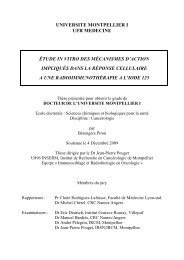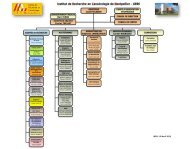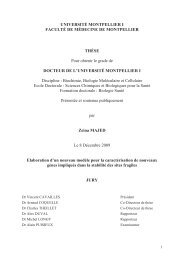Cancer du sein et micro-environnement tumoral: rôle de la protéase ...
Cancer du sein et micro-environnement tumoral: rôle de la protéase ...
Cancer du sein et micro-environnement tumoral: rôle de la protéase ...
You also want an ePaper? Increase the reach of your titles
YUMPU automatically turns print PDFs into web optimized ePapers that Google loves.
LRP1 Receptor Controls Adipogenesis and Is Up-Regu<strong>la</strong>ted In Human and Mouse Obese Adipose TissueOlivier Masson 1 , Carine Chavey 1 ,Cédric Dray 2,3 , Aline Meulle 3,4 , Danielle Daviaud 2,3 , Didier Quilliot 5 ,Catherine Muller 4 , Philippe Val<strong>et</strong> 2,3 , Emmanuelle Liaud<strong>et</strong>-Coopman 1 *1 IRCM, Institut <strong>de</strong> Recherche en Cancérologie <strong>de</strong> Montpellier, INSERM, U896, Université Montpellier1, CRLC Val d’Aurelle Paul Lamarque, Montpellier, France, 2 InstitutNational <strong>de</strong> <strong>la</strong> Santé <strong>et</strong> <strong>de</strong> <strong>la</strong> Recherche Médicale (INSERM), U858, Toulouse, France, 3 Université <strong>de</strong> Toulouse, UPS, Institut <strong>de</strong> Mé<strong>de</strong>cine Molécu<strong>la</strong>ire <strong>de</strong> Rangueil, Equipenu3, IFR31, Toulouse, France, 4 Institute of Pharmacology and Structural Biology CNRS UMR 5089, Université <strong>de</strong> Toulouse, Toulouse, France, 5 Service <strong>de</strong> diabétologie,Ma<strong>la</strong>dies métaboliques <strong>et</strong> nutrition, CHU <strong>de</strong> Nancy, Hôpital J. d’Arc, Nancy FranceAbstractThe cell surface low-<strong>de</strong>nsity lipoprotein receptor-re<strong>la</strong>ted protein 1, LRP1, p<strong>la</strong>ys a major role in lipid m<strong>et</strong>abolism. Thequestion that remains open concerns the function of LRP1 in adipogenesis. Here, we show that LRP1 is highly expressed inmurine preadipocytes as well as in primary culture of human adipocytes. Moreover, LRP1 remains abundantly synthesised<strong>du</strong>ring mouse and human adipocyte differentiation. We <strong>de</strong>monstrate that LRP1 silencing in 3T3F442A murine preadipocytessignificantly inhibits the expression of PPARc, HSL and aP2 adipocyte differentiation markers after adipogenesis in<strong>du</strong>ction,and leads to lipid-<strong>de</strong>pl<strong>et</strong>ed cells. We further show that the absence of lipids in LRP1-silenced preadipocytes is not caused bylipolysis in<strong>du</strong>ction. In addition, we provi<strong>de</strong> the first evi<strong>de</strong>nces that LRP1 is significantly up-regu<strong>la</strong>ted in obese C57BI6/Jmouse adipocytes and obese human adipose tissues. Interestingly, silencing of LRP1 in fully-differentiated adipocytes alsore<strong>du</strong>ces cellu<strong>la</strong>r lipid level and is associated with an increase of basal lipolysis. However, the ability of mature adipocytes toin<strong>du</strong>ce lipolysis is in<strong>de</strong>pen<strong>de</strong>nt of LRP1 expression. Altog<strong>et</strong>her, our findings highlight the <strong>du</strong>al role of LRP1 in the control ofadipogenesis and lipid homeostasis, and suggest that LRP1 may be an important therapeutic targ<strong>et</strong> in obesity.Citation: Masson O, Chavey C, Dray C, Meulle A, Daviaud D, <strong>et</strong> al. (2009) LRP1 Receptor Controls Adipogenesis and Is Up-Regu<strong>la</strong>ted In Human and Mouse ObeseAdipose Tissue. PLoS ONE 4(10): e7422. doi:10.1371/journal.pone.0007422Editor: Yihai Cao, Karolinska Institut<strong>et</strong>, Swe<strong>de</strong>nReceived March 9, 2009; Accepted September 22, 2009; Published October 12, 2009Copyright: ß 2009 Masson <strong>et</strong> al. This is an open-access article distributed un<strong>de</strong>r the terms of the Creative Commons Attribution License, which permitsunrestricted use, distribution, and repro<strong>du</strong>ction in any medium, provi<strong>de</strong>d the original author and source are credited.Funding: Institut National <strong>de</strong> <strong>la</strong> Santé <strong>et</strong> <strong>de</strong> <strong>la</strong> Recherche Médicale’, the University of Montpellier I, the <strong>Cancer</strong>opole Grand Sud-Ouest and the Institut National <strong>du</strong><strong>Cancer</strong> (INCA grants PL2006_035). The fun<strong>de</strong>rs had no role in study <strong>de</strong>sign, data collection and analysis, <strong>de</strong>cision to publish, or preparation of the manuscript.Comp<strong>et</strong>ing Interests: The authors have <strong>de</strong>c<strong>la</strong>red that no comp<strong>et</strong>ing interests exist.* E-mail: e.liaud<strong>et</strong>@valdorel.fnclcc.frIntro<strong>du</strong>ctionConsumption of meals rich in fat and carbohydrates is a majorcausative factor of obesity, resulting in excessive white adipose tissue.Adipos<strong>et</strong>issueservesasanenergyreservoirandasanendocrineorgan.An increase of adipose tissue mass results from combined hypertrophyof existing adipocytes (hypertrophic adipocytes) and adipogenicdifferentiation of precursor cells (hyperp<strong>la</strong>sic adipocytes) [1]. Expressionof the nuclear peroxisome proliferator-activated receptor c(PPARc) is known to be crucial for the initiation of adipocytedifferentiation. In<strong>de</strong>ed, mice with a targ<strong>et</strong>ed adipocyte-specific <strong>de</strong>l<strong>et</strong>ionof the PPARc gene disp<strong>la</strong>y a <strong>de</strong>creased adipose tissue mass [2].Activation of PPARc in<strong>du</strong>ces the expression of lipogenic genes, such asadipocyte fatty acid binding protein (aP2), and of lipolytic genes, suchas hormone-sensitive lipase (HSL) [3]. Interestingly, activated PPARcalso stimu<strong>la</strong>tes the transcription of the low-<strong>de</strong>nsity lipoprotein receptorre<strong>la</strong>tedprotein 1 (LRP1) in adipocytes [4].LRP1 is a 600-kDa multifunctional endocytic receptor that bindsand internalizes a broad range of biologically diverse ligands includingproteins important in lipoprotein m<strong>et</strong>abolism [5]. LRP1 mediates theendocytotic internalization of di<strong>et</strong>ary lipids carried in postprandialchylo<strong>micro</strong>n remnants into hepatocytes by binding to ApolipoproteinE (ApoE) [6,7], particle–bound lipoprotein lipase (LpL) [8] and hepaticlipase [9]. Interestingly, LRP1 is expressed in adipocytes [4,10,11] andinsulin stimu<strong>la</strong>tion of LRP1 increases the endocytic uptake oftriglyceri<strong>de</strong>s and cholesteryl esters from remnant lipoproteins inpostprandial adipocytes in a synergistic action with lipoprotein lipase[10]. Adipose-specific LRP1-knockout mice generated by crossingLRP1 flox/flox mice with aP2-Cre transgenic mice recently revealed itsprominent role in lipid assimi<strong>la</strong>tion affecting energy m<strong>et</strong>abolism anddi<strong>et</strong>-in<strong>du</strong>ced obesity in mature adipocytes [12]. Even through thefundamental function of LRP1 in lipid homeostasis was recentlyrevealed in mouse mo<strong>de</strong>l [12], its role in adipogenesis remains to beelucidated. Here, we report that LRP1 expression is necessary foradipocyte differentiation. Silencing of LRP1 in preadipocytes by theuse of siRNAs significantly inhibits the expression of PPARc,HSLandaP2 adipocyte differentiation markers, and leads to lipid-<strong>de</strong>pl<strong>et</strong>ed cellsinept to in<strong>du</strong>ce lipolysis. Moreover, we corroborated the key functionof LRP1 in maintaining the lipid levels in mature adipocytes. Untilnow, the implication of LRP1 in obesity has not been reported y<strong>et</strong> inhuman. Our study highlights, for the first time, that LRP1 expression isup-regu<strong>la</strong>ted in obese human tissue, and suggests that this receptor maybe an interesting therapeutic targ<strong>et</strong> in obesity.ResultsLRP1 is highly expressed in adipocytes <strong>du</strong>ringadipogenesis in mouse and humanIn or<strong>de</strong>r to explore the function of adipocytic LRP1, we firstinvestigated the level of LRP1 protein expression in preadipocytesPLoS ONE | www.plosone.org 1 October 2009 | Volume 4 | Issue 10 | e7422





